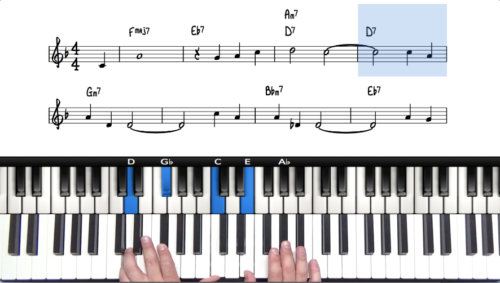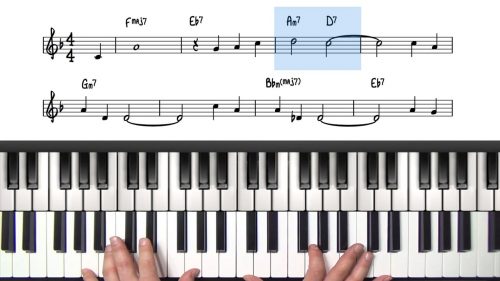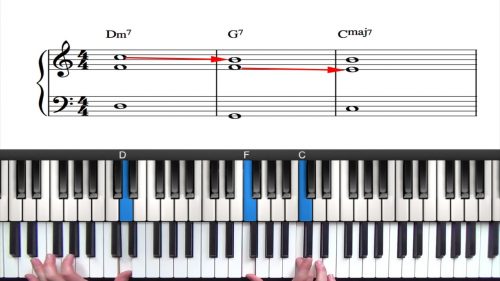"Days Of Wine & Roses" Beginner Tutorial
In this lesson we create a simple arrangement of the tune “The Days Of Wine & Roses”. The chord changes are relatively simple and there’s lots of 25s and 251s to get us familiar with these common progressions.
We will be sticking exclusively to roots, 3rds and 7ths in our voicings and of course playing the melody on top.
The Form & Harmony
The tune is written in the key of F Major and it follows an ABAC form which means that the the melody and chords for the A Sections are identical.
Practice Tips
-
Experiment with the 5th interval in the lower registers to add weight and depth to our voicings.
-
The A sections of this tune contain similar melody and harmony. Understanding the ABAC speeds up out memorisation of the tune.
-
After learning this basic arrangement, check out the more advanced tutorial on this tune.
- Listen to the notable recordings of the tune for additional inspiration.







Hello Hayden: is this one of those tunes where improvisation is just …..hmm….difficult or just not possible? Playing a couple of choruses with embellishments …yes….but improvisation….not so much?
You said that you love to play it. Do you also improvise on it or …?
Just curious. Thanks, Smole
Sorry, Hayden, that was a stupid question. I forgot to visit Youtube and Spotify and got many answers to my question. I still think that some ballads are just not amenable to improvisation and mistakenly thought that this was one of those. Best, Smole
Hey Smole 👋
Not a stupid question at all!
Whilst this tune can be played as a ballad. If we listen to various versions of this song on YouTube or Spotify we will hear that it is often performed at a medium/up-tempo. Using tools like the iRealPro is helpful to stay in time whilst exploring improvisation over the form.
Memorising the chord changes is an important step to ‘free ourself from the lead sheet’ and to fully immerse ourself in our improvisation. Being comfortable with the left hand voicings would also be useful if playing along with a backing track.
Exactly as you say, studying, transcribing, and playing along with our favourite improvisations over the song is the most important step.
I like to study how the recordings transition from the head of the song into the improvised solos. I find this useful to ‘springboard’ myself from playing the melody into exploring improvised ideas over the chord changes.
Hope this helps and any other questions let me know.
Cheers,
Hayden
Thank you, Hayden, again for your patience. I don’t know why I did not do a more thorough search, I would have found three lessons on this tune on PG and other related lessons (all of which I am now more thoroughly studying). So, I am going to be ok after I complete all that staff.
Thanks again, Smole
Hi Smole.
Yes I completely forgot about those lessons!
If I remember correctly we study a Beegie Adair recording which has a beautiful solo over this tune.
It’s a newer recording so the audio clarity is high quality making it easier to transcribe from than older recordings.
Glad you found the lesson.
Cheers,
Hayden
Hayden,
I have some arthritis in my hands so I have trouble reaching some of your voicings. On the simplified Days of Wine and Roses an example would be the voicing for the second chord, Eflat7.
The right hand is G-Dflat-A.
So should I just roll this with my R hand or use my left hand to arrpegiate up from the root to the G?
Thanks!
Hi Vincent 👋🏻
Apologies for the late response here.
If a voicing is too big a stretch, we have 2 options:
1) Rearrange the notes into a smaller section of the piano
2) Roll the notes using the sustain pedal
Both have their merits.
First try to bring your left hand up and octave, and play Eb and G (root and 3rd) and then play Db and A with your right hand (b7 and the #11). The chord will not be as deep, but we still have the essential chord tones in there.
Then yes the next option is to roll the notes. It’s difficult to say which hand would be easier for you, so I would try both. Ultimately Vincent try to find the method that is most comfortable for you and that way you can incorporate this into your playing style.
I hope this helps and any further questions just let me know.
Cheers,
Hayden
Thanks!
hello,
In “I’ll be home for Christmas” you ,added “roll up” to improve the music. In “Wine & Roses” you seem to do the same thing but call it “toggle”. Are these all forms of chord arpeggio’s?
It really improves the sound of the song. Are there are guides/rules to follow to achieve the sound.
It is very difficult to follow in the video even at the slowest speed.
Thanks, Joe Schrank
Hi Jospeh 👋🏻
Apologies for the late reply here.
Yes this style of voicing is called ‘block chords’. We have a dedicated course on that area here: pianogroove.com/jazz-piano-lessons/block-chords-drop-2-voicings/
This style of voicing works best with step-wise melodies, and when the melody outlines the primary chord tones of the underlying harmony, ie. 1-3-5-7 of the chord. We then play the chord and its inversions with the top and bottom note doubled, using both hands to create a the block chord sound.
The “roll up” in the left hand is a stylistic touch which emphasises the bottom voice in the chord. If you listen to players like Barry Harris, George Shearing, and Bud Powell, you will hear this style of voicing in their playing.
Check out the course referenced above, and that should answer all of your questions.
If I can help you with anything else just let me know.
Cheers,
Hayden
Hello dear teachers and community,
i ask me, in which harmonical context does the Eb7 stays, between the Fmaj7 and the Am7 in the A-part of the song.. ‘wondering if its really meant as an altered VII or maybe it’s a substituiton of… mmh ???
i think you guys know the answer… i hope, i’ll soon too ;)
greetings to all
Nobby
Hi Nobby, thanks for writing!
Eb7 in the key of Fmaj functions as a IV-minor, as Eb7 is the same thing as Bb-7 (remember the II V connection!
This harmonic event has been around since the dawn of western music, and appears in all genres, from Bach to pop- and jazz music.
In this case you can think of the Eb7 as Bb-, which would resolve to Fmaj (see attachment). Instead of Fmaj, the next chord is A-7. A-7, the 3rd degree in the key of Fmaj works as a substitute for the tonic, as 3rd degree functions as an alternative to the 1st degree. Reason why that works is that the notes of A-7 are very much the same as Fmaj, the tonic (attachment).
Let me know if this helped, or if you have any further questions!
all the best,
-Tuomo
Hello Tuomo,
thanks for this clear and extensivly explanation. Substituting the tonic with 3rd and 6th degree seem quite comprehensible for me – there’s just one note difference between the chords, but that IVminor – thing .. i have to think about it and puzzle at the keys…without your explanation i’d never came to that solution. I really love those harmonic deep insights puzzles…
musical greetings from Germany
Nobby
I’m glad to help Nobby, let me know if you have any further questions!
Viel Spaß,
-Tuomo
Hello Hayden. I’ve noticed that this tune doesn’t have a transcription for the arrangement you played. Should we as beginners try to create our own arrangemetn’s at this point? I’m starting to understand the spreading of the chord along the piano concept, as far as my fingers can stretch. Between the bass note, and the melody.
Hi Nelson 👋🏻
Yes I must create the transcription for this lesson. I will get it done and uploaded this week for you.
Yes it’s always good to be arranging your songs. I’d recommend to learn 20 or so of the arrangements on the website and then you will be much more comfortable with reading and interpreting lead sheets.
The next step is to choose a tune, and I like to create a playlist with all of my favourite versions on YouTube and/or Spotify. I will then listen over and over, transcribe bits that I like, and gradually create an arrangement.
If you are new to transcription, check out the ear training exercises in the forum:
pianogroove.com/community/c/improvisation-exercises/
I’d recommend starting with the Beginner/Intermediate ones.
Cheers,
Hayden
hello Hayden, where you able to do the transcription for this tune? I’m having a hard time memorizing all from the video. Thanks !
Hi Nelson,
Apologies for the delay here, I will do it today for you.
Cheers!
Hayden
Hi Nelson 👋🏻
I have just added the transcription for this tune – see the “Downloads” section… apologies again for the delay.
If I can help you with anything you are working on just let me know.
Cheers,
Hayden
thank you so much Hayden!
Hi Tuomo,
I’m missing tons of foundational concepts. I don’t get the explanation of the Eflat7 chord in Days of Wind and Roses as the same a B flat minor 7. Could you expand further Thank you.
Hi Amelia, thanks for writing. Here some thoughts:
Let’s start from the basis of music. Everything in harmony is either tension (V chord a.k.a dominant)or release/resolution (I chord a.k.a tonic, that can be any chord where the V chord/tension is resolving).
So, now let’s look at the V chord. Here in the key of C major (attahcment), G7 – Cmaj7.
Every time you have a V chord, you can have a sort of “introduction” to the tension, in jazz we use the II chord, in the key of C major it would be D-7, and play it before the V, G7 (attahcment).
This is called the II V I, where II V works as the tension, and I is the tonic.
The chords of the II V (D-7 and G7) should ALWAYS be perceived as one thing; for example you can use only the V chord to resolve to a tonic without using the II (and vice verca). Still we should be thinking the II chord is there, as it is a fundamental part of the tension in jazz.
So, if we consider II and V chord to be the same thing, we should be treating them as one thing, doesn’t matter if played separate or together.
With this logic, whenever you see a dominant chord, you should be thinking of/”adding” the II chord in front of it, if not playing it but at least in your mind.
Here few example exercises, can you name the II chord, if the V chord is:
A7
C7
F7
Bb7
Eb7?
After you answer these, we can move forward, and talk about your actual question!
Let me know if you have any questions about this,
-Tuomo
Hi Tuomo, I remain confused. To answer your questions:
If A7 is V, then E-7 is II
If C7 is V, then G-7 is II
If F7 is V, then C-7 is II
If Bb7 is V, then F-7 is II
If Eb7 is V, then Bb-7 is II
So in the case of this song, the II for Eb7 is Bb-7. What I can’t fathom is how this applies to the key of F. The notes in Bb-7 are Bb, Db, F, Ab; but Db and Ab are not in the key of F. Is this a one-bar modulation to another key?
All of the chords in this song fit within the key of F except Eb7 and G7. My ear tells me they sound right but my brain can’t grasp why. I know this is very much a rock-bottom beginner question; if there is material explaining the basics on this site, please feel free to point me to it. Thanks.
Hi Dan, thanks for writing!
First, all the example exercises were correct, great!
About the Bb-7 (or Bb-7 Eb7 II V), I copied the explanation from the comment section earlier:
Eb7 in the key of Fmaj functions as a IV-minor, as Eb7 is the same thing as Bb-7 (remember the II V connection!). So you can think of it as “borrowed” from the same minor key, in this case F minor.
This harmonic event has been around since the dawn of western music, and appears in all genres, from Bach to pop- and jazz music.
In this case you can think of the Eb7 as Bb-, which would resolve to Fmaj (see attachment). Instead of Fmaj, the next chord is A-7. A-7, the 3rd degree in the key of Fmaj works as a substitute for the tonic, as 3rd degree functions as an alternative to the 1st degree. Reason why that works is that the notes of A-7 are very much the same as Fmaj, the tonic (attachment).
About the G7, this is also a very common harmonic event, so called ‘5 of 5’, or a secondary dominant.
In the key of Fmaj, G7 works as a substitute for G-7 (II), when G-7 is a part of G-7 C7 II V. As C7 is the next chord after G-7, G7 works very well as it is a dominant (V) to C, thus creating more dominant – tonic movement within the II V, eventually resolving to Fmaj: G7 – C7 – Fmaj7.
Here is a tutorial on the subject of 5 of 5:
pianogroove.com/jazz-piano-lessons/secondary-dominant-chords/
Let me know if this helped, or if you have any further questions!
all the best,
-Tuomo